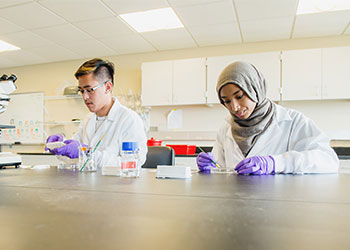Dr. Sujean Choi's Research
Our lab examines how the brain alters hunger, food intake, and subsequently body weight. Our work contributes to understanding health problems such as obesity, eating disorders, metabolic disorders, and depression and ultimately to the development of more effective therapeutic strategies.
My primary research program involves preclinical studies exploring the role of the central nervous system in the regulation of energy homeostasis and its neuroanatomical mapping. Towards this goal, we examine brain mechanisms underlying constituent elements of energy homeostasis such as motivated feeding behavior, circadian rhythms, metabolism, fat deposition, endocrine and neuropeptide signaling systems, and body weight to broadly evaluate phenotypic and neuroanatomic changes in animal models of disease. Recently, my research program has begun to focus on the functional and mechanistic intersection between contemporary neuropeptides and peptide hormones in the regulation of feeding behavior. To address these questions, my lab utilizes a number of behavioral, molecular and imaging methods and techniques (e.g. in situ hybridization, immunohistochemistry, track tracing, circuit capture, FACS) to characterize neural circuits that support both behavioral and physiological responses.
It is standard procedure in our lab to measure changes in both gene and protein expression as well as determine their anatomical distribution using bright field, dark field, and fluorescent (including confocal) imaging techniques. We are currently exploring the mechanistic interactions between neuropeptides and circulating peptide hormones in the hypothalamus on the regulation of feeding behavior and how these relationships may change from a lean to obese state. Specific projects include leptin-PACAP interactions in the hypothalamus and compulsive or binge eating behavior stemming from the striatal motive circuit. While studies have often examined signaling molecules in isolation in order to better characterize their roles and actions, it is equally important to understand how they differentially interact or become altered through shared signaling pathways, which can be overlooked when exploring them individually. The outcomes of my research program will contribute to a broader understanding of how organisms regulate normal vs. pathological feeding behavior at a genetic, physiological, and systems level as well as provide new insight into the integrated circuitry contributing to pathological changes that interconnect multiple signaling systems and modalities.
Selected Publications
- Hurley, M.M., Maunze, B., Block, M., Frenkel, M., Reilly, M.J., Kim, E., Chen, Y., Li, Y., Baker, D.A., Liu, Q.S., and Choi, S., (2016) Pituitary adenylate-cyclase activating polypeptide regulates hunger- and palatability-induced binge eating. Frontiers in Neuroscience Aug 22 10:383. doi: 10.3389/fnins.2016.00383
- Hurley, M.M., Resch, J. M., Maunze, B., Frenkel, M.M., Baker, D.A., Choi, S. (2016) N-acetylcysteine (NAC) decreases binge eating in a rodent model. International Journal of Obesity40(7):1183-1186.
- Resch, J.M., Maunze, B., Gerhardt, A., Magnuson, S.K., Phillips, K.A., Choi, S. (2013) Intrahypothalamic pituitary adenylate cyclase-activating polypeptide regulates energy balance via site-specific actions on feeding and metabolism. American Journal of Physiology, Endocrinology and Metabolism 305(12):E1452-63
- Fernstrom, J.D. & Choi, S (2007) The development of tolerance to drugs that suppress food intake. Pharmacology and Therapeutics. 117(1): 105-122.
- Bhargava, A., Dallman, M.F., Pearce, D., Choi, S. (2004) Long double-stranded RNA-mediated RNA interference as a tool to achieve site specific silencing of hypothalamic neuorpeptides. Brain Research Protocols. 13:115-25.


